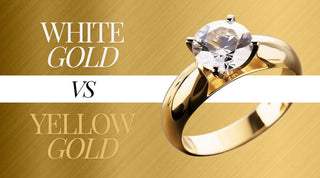Choosing the perfect metal for your engagement or wedding ring is a big challenge, especially when it's between the two most popular options: yellow and white gold. Both metals have unique qualities and aesthetics and could create a stunning piece. Let's explore the key differences between white gold and yellow gold, including their composition, price, quality, and more, to help you make an informed decision!
Which is Better, White Gold or Yellow Gold?
Much of your choice will depend on your individual style. Other key factors, such as aesthetics, maintenance, and personal preferences, may also influence your decision.

White gold's aesthetic is sleek and modern with a silvery hue. It complements cooler skin tones and enhances diamond brilliance, perfect for contemporary ring designs. Yellow gold works best with warmer skin tones and has a more classic aesthetic that pairs beautifully with traditional settings.
White and yellow gold are durable, long-lasting metals, but both can still develop scratches or wear over time. Yellow gold is more naturally durable and requires less upkeep in the long run. White gold is often coated with rhodium for extra protection and shine. Over time, this coating can wear off, requiring periodic re-plating to maintain its appearance.
For centuries, yellow gold has been considered a symbol of wealth and status, often seen in royal or ceremonial jewelry. White gold was introduced in the 1920s as a substitute for platinum, offering a modern alternative with a luxurious feel. Depending on cultural influences or personal traditions, one metal may resonate with you more than the other.
Is White Gold a Real Gold?
Yes, white gold is a genuine gold type. It achieves its distinctive color by mixing pure gold with other metal alloys, including nickel and zinc. These metals lighten the color of the gold and add strength and durability. Many manufacturers then coat the final product with rhodium to enhance its brilliance and provide a reflective finish.

Some people mistakenly believe white gold is not "real" because of its color. However, the gold content in white and yellow gold of the same karat is the same. The color difference is due to the various metals mixed in with the pure gold.
White gold, like yellow gold, comes in different karats, which indicate the percentage of pure gold in the alloy. For example, 18K white gold contains 75% gold, while 14K white gold contains 58.3% gold. The remaining percentage is made up of the alloying metals.
Which Color of Gold is the Most Expensive?
The price of gold can vary depending on several factors, including the metals used in the alloy and current market trends.

The rhodium plating process can increase the cost of white gold. Rhodium is a rare and expensive metal, and the plating needs to be reapplied over time, making white gold jewelry more costly to maintain.
Metal prices are influenced by market demand. For instance, if there is a higher demand for white gold due to its popularity in modern designs, prices will likely reflect this trend.
Do Diamonds Look Better in White or Yellow Gold?
A ring's metal color can significantly impact a diamond's appearance.

For example, white gold enhances the brilliance and sparkle of diamonds, providing a neutral backdrop for the diamond's fire to stand out. Conversely, yellow gold can give diamonds a warmer appearance, which can be especially appealing for diamonds with a slight color, as the yellow tint can blend harmoniously with the stone.
White gold is often used in modern or minimalist settings, focusing on showcasing the diamond, whereas yellow gold is frequently seen in vintage or ornate settings, where the metal's warm tone complements intricate designs.
Ultimately, whether a diamond looks better in white or yellow gold depends on personal taste. Some prefer white gold's bright, clean look, while others are drawn to yellow gold's rich, traditional appearance. Which do you prefer?
Is 14K or 18K White Gold Better?
When deciding between 14K and 18K white gold, you must consider the balance between purity and durability.

18K white gold contains more pure gold (75%) than 14K white gold (58.3%). This means that 18K white gold has a richer, warmer color, even after the rhodium plating. However, it is also softer and more prone to scratches than 14K white gold, which has a higher proportion of harder alloy metals.
Due to its lower gold content and higher concentration of harder metals, 14K white gold is more durable than 18K white gold. This makes it a better option for those with an active lifestyle or who prefer a ring requiring less maintenance.
Due to its higher gold content, 18K white gold costs more than 14K white gold. If budget is a concern, 14K white gold can achieve the same look while being more affordable.
Making the Right Choice
Deciding between white and yellow gold is a personal decision that requires you to weigh various factors, including appearance, price, quality, and preference. Understanding the key differences and considerations allows you to select the perfect metal for your engagement or wedding ring. Good luck and happy ring shopping!



